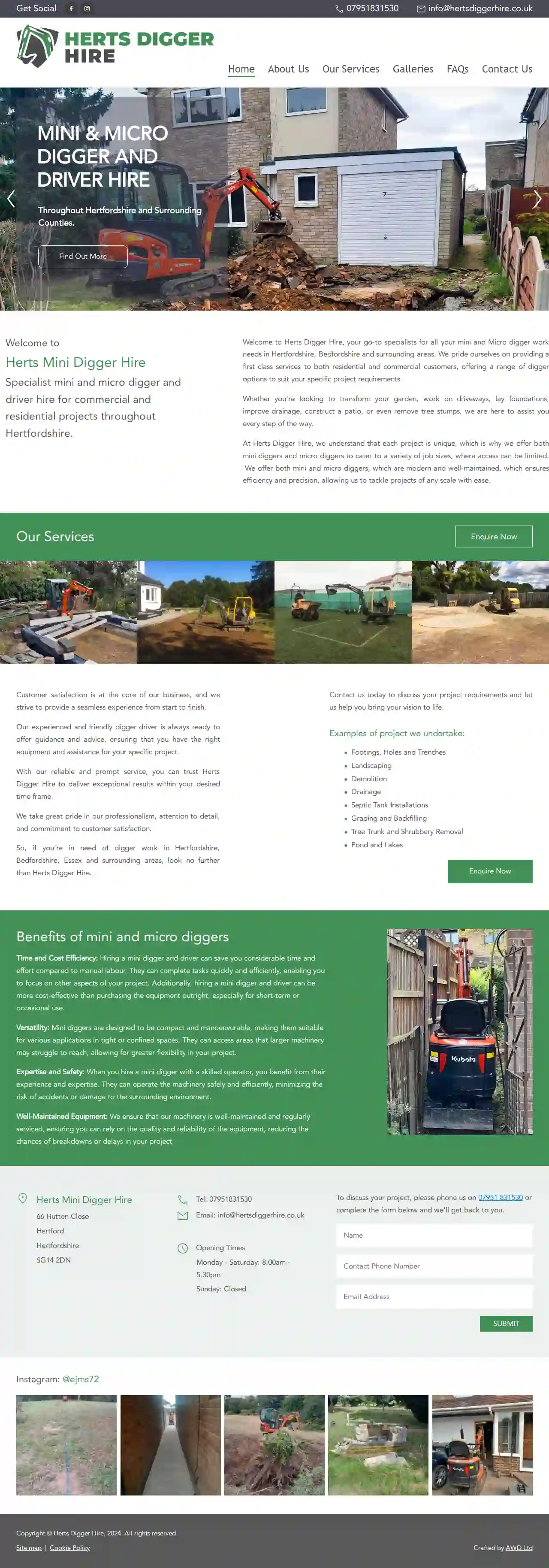Excavation Contractors Harpenden
Find Excavating Contractor in Harpenden
Receive 3 FREE Land Excavation quotes for your project today! Compare profiles, reviews, accreditations, portfolio, etc... and choose the best deal.

Herts and Essex Site Investigations (HESI)
54 reviewsUnit J8, Peek Business Park, Woodside, Bishops Stortford, Hertfordshire, CM23 5RG, GBExperienced Geotechnical & Environmental engineers HESI is a well-established company based in the South-East of England and offer a wide range of Geotechnical and Environmental Services across the south of England and wider area extending to the north. HESI offer a wide range of services to a huge array of clientele and consistently strive to meet clients needs for an economical but thorough service. Our expertise provides: Pragmatic approach HESI offer a direct and pragmatic approach to site investigation providing a quick and easy service for our clientele to develop construction sites. We provide a hands on service with an energetic delivery of resources and data. Rapid response HESI can provide rapid responses to clients needs. Often a speedy inspection or site visit is required and HESI strive to meet the needs of clientele. Health and Safety HESI provide all necessary Health and Safety information to enable all works to proceed in line with best practice and can provide Risk Assessment and Method Statements for all elements of works. Discreet service HESI can provide a discreet service where required to minimise disturbance in delicate sites which may require a level of discretion.
- Services
- Why Us?
- Our Team
- Testimonials
- Gallery
Get Quote
DBacon and Son LTD
1Hertford, GBWelcome to DBacon And Son LTD Quality Comes First Our family-run construction company has been synonymous with unwavering quality, integrity, and a deep-rooted commitment to craftsmanship. With a reputation that starts from a family working together, we have built our values on a foundation of trust and an enduring passion for construction. With this long-established presence in the industry, it has allowed us to foster enduring relationships with clients, subcontractors, and suppliers. This network of trust enables us to consistently deliver projects of exceptional quality, on time, and within budget. As a well-respected name in the field, we take immense pride in our ability to bring dreams to life, whether it's creating a dream home, revitalizing a community space, or constructing a commercial landmark.
- Services
- Why Us?
- Gallery
Get Quote
Hertford Museum
4.5157 reviewsHertford, GBWelcome to Hertford Museum Discover the heart and soul of Hertford and its surrounding villages at Hertford Museum. Caring for over 100,000 fascinating objects, the museum offers a captivating journey through time. Explore collections spanning archaeology, natural history, art, geology, world cultures, social history and the Hertfordshire Regiment. There’s something to inspire everyone. Whether you’re a local resident or a curious visitor, we invite you to immerse yourself in the rich tapestry of Hertford’s heritage. A particular highlight is the Addis Company Archive, boasting the world’s largest collection of toothbrushes. Hertford Museum is a cherished community resource, which relies on the generous support of visitors and donors to maintain its vital work. With a weekly running cost of approximately £4,000, your generous contributions make a significant difference in preserving the rich and vast history of East Hertfordshire.
- Services
- Why Us?
- Gallery
Get Quote- Je
Jex Plant Uk Ltd
52 reviewsStevenage, GB- Services
- Why Us?
Get Quote 
Screw Pile Base Systems
1102 North Road, Hertford, SG14 2BZ, GBAbout us Screw Pile Base Systems has a construction history going back to 1997. The Screw pile system evolved in 2007. We searched for a better way for foundations to be created without the need for large amounts of earth removal which in turn involved large amounts of concrete. Screwpiling is at the core of our business to help create a fast, clean, environmentally sustainable, low vibration, low noise, removable, tree friendly, building regulation, fully designed way of providing a vast range of foundation base systems. Extensions Using the screw pile system makes it an ideal system for extensions or stand-alone housing. This system can either be transported though your front door or craned in if required. As the screw pile does not require any earth removed during installation the need of a party wall act can be eliminated, as you are not undermining your neighbour’s foundation. This can save huge costs and risks for yourself and neighbour! We can provide a modular build system which complies to building regulations above and beyond what’s required! A modular SIP/ Light Gauge steel (structural insulated panel) 7 times stronger than timber frame will pay for itself over its lifetime from money saved on heating bills. Hot in winter and cool in summer, this fast system of building favours what is required by today’s demanding regulations, rising utility bills and climate conditions. Minimal excavations or even no dig! Tree safe approved system! (recommend by local authorities) Through a doorway foundation building system! (If necessary) No Vibration low noise! Build Air tight and lower your heating bills! Faster with less disruption
- Services
- Why Us?
- Gallery
Get Quote- Sc
Schye Construction Ltd
59 reviewsHertford, GB- Services
- Why Us?
Get Quote 
Herts Digger Hire
55 reviewsHerts Mini Digger Hire, 66 Hutton Close, Hertford, SG14 2DN, GBHerts Digger Hire: Your Go-To for Mini and Micro Digger Services in Hertfordshire Welcome to Herts Digger Hire, your trusted partner for all your mini and micro digger needs in Hertfordshire, Bedfordshire, and surrounding areas. We've been serving both residential and commercial customers since 2005, building a reputation for quality, reliability, and customer satisfaction. We understand that every project is unique, which is why we offer a range of modern and well-maintained mini and micro diggers to suit your specific requirements. Whether you're transforming your garden, working on driveways, laying foundations, improving drainage, constructing a patio, or removing tree stumps, we've got you covered. Our experienced and friendly digger drivers are always ready to offer guidance and advice, ensuring you have the right equipment and assistance for your project. We pride ourselves on our prompt and reliable service, delivering exceptional results within your desired timeframe. At Herts Digger Hire, we're committed to: Providing a first-class service to both residential and commercial customers. Offering a range of digger options to suit your specific project requirements. Ensuring efficiency and precision with our modern and well-maintained equipment. Delivering exceptional results within your desired timeframe. Prioritizing customer satisfaction and providing personalized solutions. Contact us today to discuss your project requirements and let us help you bring your vision to life.
- Services
- Why Us?
- Gallery
Get Quote- Co
Construction Cost Advice
1Hertford, GB- Services
- Why Us?
Get Quote 
Elliotts Drainage Solutions
4.927 reviewsUnit 13 Chells Ind. Estate, Stevenage, SG2 0LQ, GBProfessional drainage services for commercial, industrial and residential clients across the UK. From drain CCTV surveys and tanker services to unblocking and repairs, we’ve got you covered. We provide drainage services on a one-off call out basis, project works or on a retained PPM schedule for retained clients to keep your drainage systems working efficiently. WHY CHOOSE ELLIOTTS DRAINAGE? See for yourself
- Services
- Why Us?
- Gallery
Get Quote- Ta
Taylor Rose Hertford
3.795 reviewsHertford, GB- Services
- Why Us?
Get Quote
Over 11,537+ Excavation Pros onboarded
Our excavation experts operate in Harpenden and surrounding areas!
ExcavationHQ has curated and vetted the Best Excavation Contractors in and around Harpenden. Find a trustworthy business today.
Frequently Asked Questions About Excavation Contractors
- Project Size and Scope: Larger, more complex excavations naturally take longer.
- Soil Conditions: Rocky or challenging soil types can slow down progress.
- Site Accessibility: Limited access might require more time for maneuvering equipment and hauling materials.
- Weather: Inclement weather can cause delays.
- Permitting and Inspections: Waiting for permits or inspections can extend the timeline.
- Clearly Define the Scope: Outline the project's goals, including the excavation area, depth, grade, and intended use.
- Obtain Necessary Permits: Research and acquire any required permits from your local authorities.
- Mark Utility Lines: Contact your utility companies to locate and mark underground utilities to prevent damage.
- Communicate with Neighbors: Inform your neighbors about the project's timeline and potential noise or disruptions.
- Prepare the Site: Clear any obstacles, such as vegetation, furniture, or structures, from the excavation area.
- Discuss Safety Protocols: Review safety procedures with the contractor to ensure a safe work environment.
How long does an excavation project take?
What is the difference between cut and fill excavation?
Cut: Involves excavating soil from an area where the existing grade is higher than the desired grade.
Fill: Refers to using the excavated soil ('cut' material) to raise the grade in an area where the existing grade is lower than desired.
This method minimizes the need to import or export soil, reducing costs and environmental impact. It's commonly used for site preparation, road construction, and landscaping.
What should I do before excavation starts?
What is the difference between topsoil and subsoil?
Topsoil: The uppermost layer, typically rich in organic matter, nutrients, and microorganisms. It's essential for plant growth and is often darker in color.
Subsoil: The layer beneath the topsoil, containing less organic matter and generally denser. It provides support for roots but is less fertile than topsoil.
During excavation, topsoil is often removed and preserved separately for later use in landscaping, while subsoil is typically used for backfilling or other less demanding applications.
How long does an excavation project take?
- Project Size and Scope: Larger, more complex excavations naturally take longer.
- Soil Conditions: Rocky or challenging soil types can slow down progress.
- Site Accessibility: Limited access might require more time for maneuvering equipment and hauling materials.
- Weather: Inclement weather can cause delays.
- Permitting and Inspections: Waiting for permits or inspections can extend the timeline.
What is the difference between cut and fill excavation?
Cut: Involves excavating soil from an area where the existing grade is higher than the desired grade.
Fill: Refers to using the excavated soil ('cut' material) to raise the grade in an area where the existing grade is lower than desired.
This method minimizes the need to import or export soil, reducing costs and environmental impact. It's commonly used for site preparation, road construction, and landscaping.
What should I do before excavation starts?
- Clearly Define the Scope: Outline the project's goals, including the excavation area, depth, grade, and intended use.
- Obtain Necessary Permits: Research and acquire any required permits from your local authorities.
- Mark Utility Lines: Contact your utility companies to locate and mark underground utilities to prevent damage.
- Communicate with Neighbors: Inform your neighbors about the project's timeline and potential noise or disruptions.
- Prepare the Site: Clear any obstacles, such as vegetation, furniture, or structures, from the excavation area.
- Discuss Safety Protocols: Review safety procedures with the contractor to ensure a safe work environment.
What is the difference between topsoil and subsoil?
Topsoil: The uppermost layer, typically rich in organic matter, nutrients, and microorganisms. It's essential for plant growth and is often darker in color.
Subsoil: The layer beneath the topsoil, containing less organic matter and generally denser. It provides support for roots but is less fertile than topsoil.
During excavation, topsoil is often removed and preserved separately for later use in landscaping, while subsoil is typically used for backfilling or other less demanding applications.